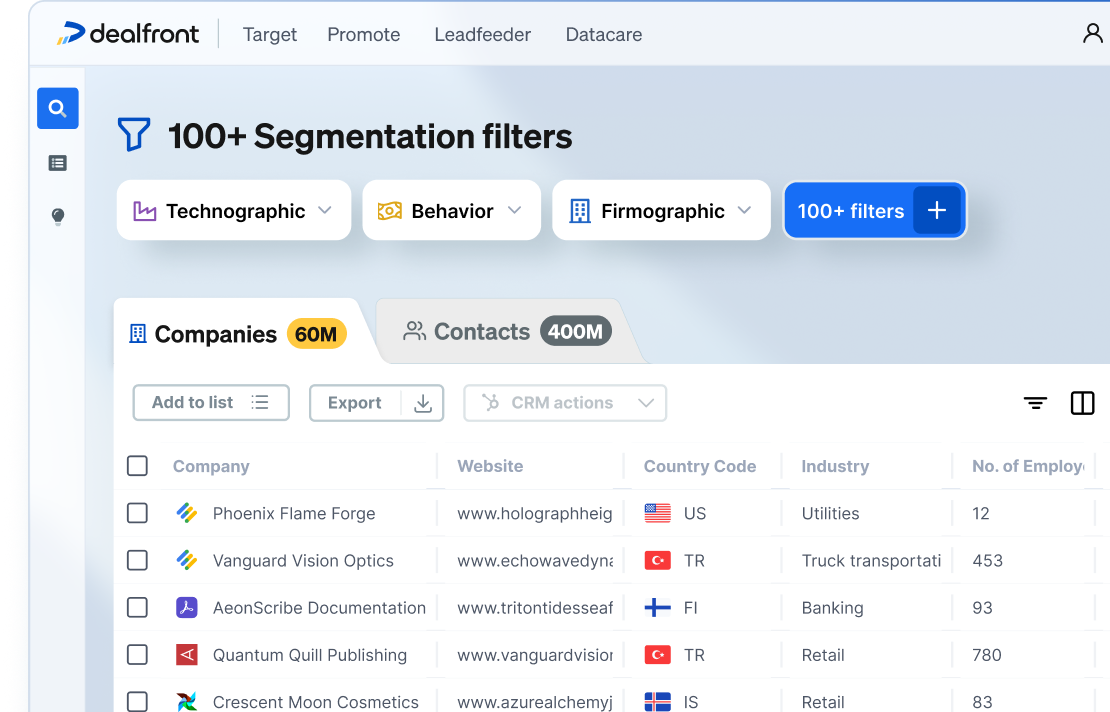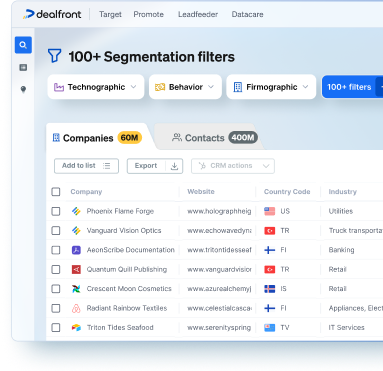How to Automate Lead Research for Event Campaigns
Erwartete Ergebnisse
2x increase in summit registrations
70% faster lead research
Improved targeting and personalization across channels

Planning a summit is hard. But getting the right people to show up? Well, that’s even harder.
Imagine this: you’ve built a tailored agenda, handpicked your dream audience, and planned the perfect outreach. But you’re stuck in the slow lane, scraping LinkedIn, Googling company names, and wading through irrelevant accounts. The clock is ticking, and your team is burning time on grunt work instead of building momentum.
That’s the challenge AutomatiKing, a B2B marketing agency, found themselves when launching targeted summits for enterprise clients. Their events were focused, their outreach was multichannel, but their lead research process couldn’t keep pace with their growth.
Working with Stefano De Carlo, CEO of AutomatiKing, and a trusted Dealfront community partner, they implemented an intent-based, automated lead research process that aligned event marketing with predictable pipeline generation. The results?
Every summit campaign ran faster and smarter.
Leads were better qualified from the start.
Registrations doubled, without burning the team out.
This playbook shows you exactly how they did it, step-by-step, so you can do the same. You’ll learn how to:
Use custom feeds to surface high-fit companies for your event.
Qualify and segment accounts by real intent signals (pricing page visits, location, industry).
Push tagged companies into LinkedIn, WhatsApp, or email flows for instant outreach.
Track conversions and refine targeting for future events.
Whether you’re running webinars, summits, or in-person roadshows, this play will show you how to ditch manual prospecting and focus on the accounts that actually move the needle.
Why traditional event prospecting falls short
In B2B events, whether it’s a trade show, summit, or virtual roundtable, the same mistake keeps happening: teams are relying on cold lists, mass outreach, and vague personas to drive signups.
Here’s the problem:
It’s slow: weeks spent manually researching contacts.
It’s costly: budgets vanish on ads and sponsorships with uncertain ROI.
It’s low yield: the wrong people show up, or no one converts at all.
Manual prospecting also ignores the most important factor: who’s in-market right now. You’re working blind, chasing people who may have no interest, while the right accounts slip by unnoticed. Not ideal.
What AutomatiKing did differently
AutomatiKing flipped the process on its head when they decided to start with intent, not contacts. Using Dealfront, they could:
Identify companies actively showing interest in topics related to their events.
Segment by location and ICP to pinpoint the right buyers.
Enrich every lead with firmographic data automatically.
Launch coordinated outreach across LinkedIn, email, and WhatsApp in record time.
The outcome was a fully automated, high-intent campaign that doubled registrations and cut manual research time by 70%.
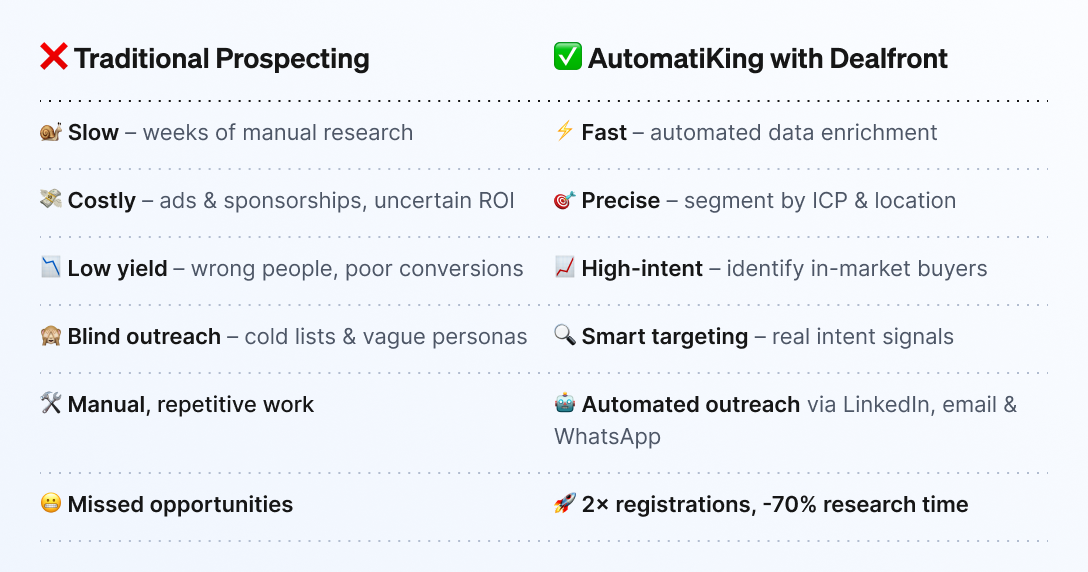
Why this playbook works so well
Too many B2B lead generation campaigns are built on guesswork: guessing who your buyer is, what they care about, and whether they’re actually ready to engage. And this results in bloated contact lists, generic outreach, and lukewarm leads.
This Play flips the script by removing the guesswork entirely. Instead of starting with a cold contact list, you begin with real, live intent signals from companies actively showing interest in topics related to your event. Then, you filter that down to match your Ideal Customer Profile (ICP) and event relevance. The process doesn’t just speed up lead research, it automates enrichment, giving sales a head start with personalized, multi-channel outreach.
When you stop chasing and start attracting the right accounts, everything changes:
Conversion rates climb.
Follow-ups feel natural, not forced.
Sales cycles shorten because buyers are already primed.
This is why AutomatiKing doubled registrations without adding headcount, and why you can too.
Step-by-Step: Automating Lead Gen for event campaigns
Here’s the exact sequence AutomatiKing used to turn their summits into high-intent, high-conversion machines. From defining a crystal-clear audience to running multi-channel outreach, every step was designed to cut manual work and scale results.
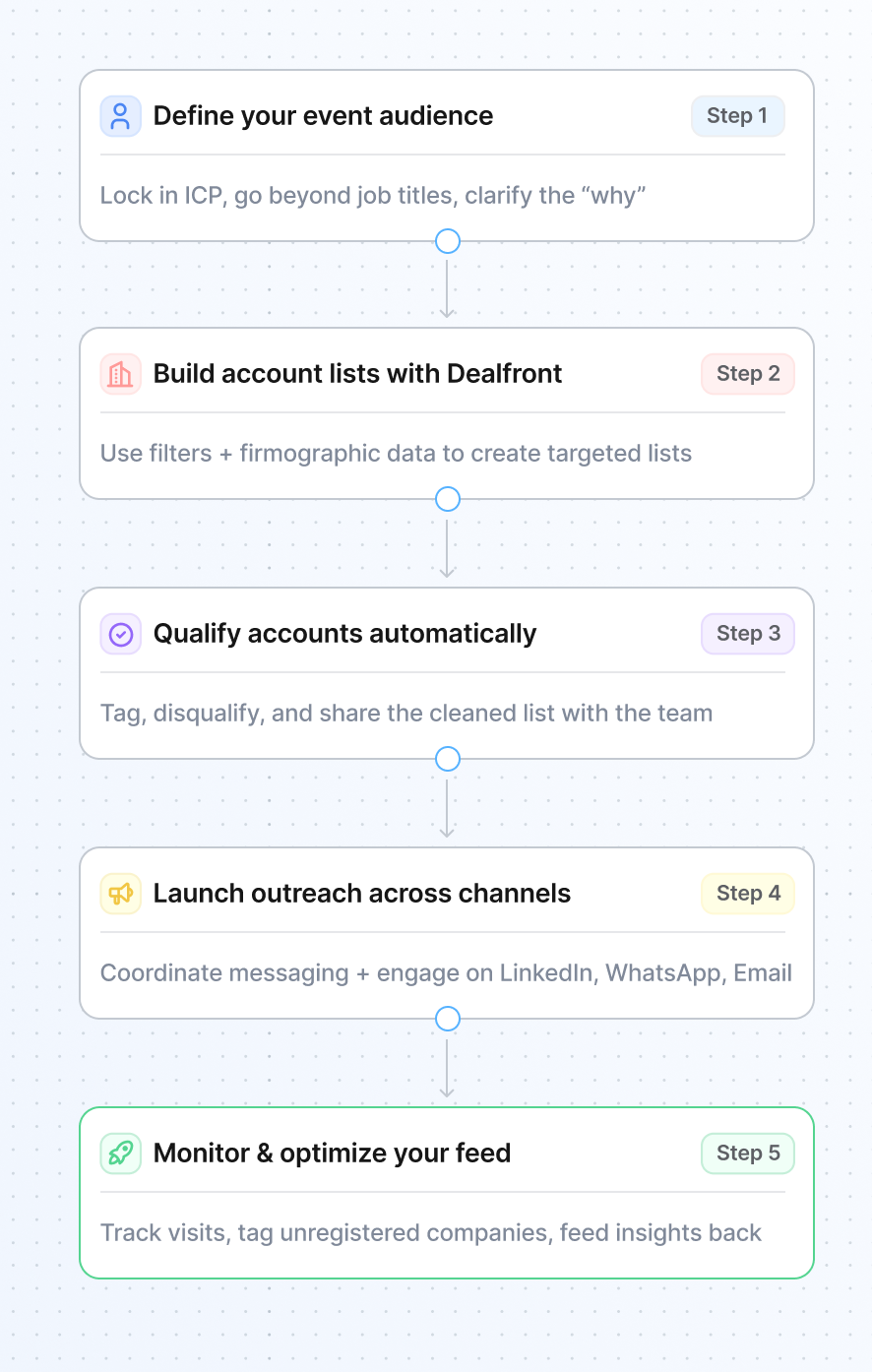
Step 1 – Define your event audience
The best events aren’t for everyone, they’re for someone. Your job is to know exactly who that someone is.
What to do:
Lock in your ICP, considering industry, company size, region, and budget range.
Go beyond job titles and define functional roles, e.g., “those managing marketing agencies” instead of “Marketing Director.”
Clarify the “why”. Think: what’s the burning reason this audience should care about the event? Build messaging before you build the list.
AutomatiKing’s move:
They focused on functional responsibilities (e.g., event management) instead of relying solely on job titles, which vary wildly between industries. This ensured their lists captured the right people, even if their titles weren’t an exact match.
Step 2 – Build account lists with Dealfront
Once your audience is clear, use Dealfront’s filters and firmographic data to create an account list that’s ready for outreach, no spreadsheets and no scraping.
What to do:
Create custom feeds by industry and region (e.g., “Marketing Agencies – Italy”).
Filter by firmographics like revenue, headcount, or technology stack.
Tag companies with campaign-specific labels (e.g., “Summit Lead Italy May 2025”) so you can find them instantly.
AutomatiKing’s move:
For each summit, they built targeted account lists by theme and geography. This gave them a clean, ready-to-use dataset in minutes, something that used to take days of manual research.
Step 3 – Qualify accounts automatically
Not every account in your feed is going to be worth your time, so the faster you can filter them, the better.
What to do:
Use Dealfront’s tags like “Too small,” “Already a customer,” or “Competitor” to instantly segment.
Disqualify in the UI or sync rules directly into your CRM.
Share your cleaned, qualified list with SDRs or channel owners.
Pro Tip: Save your filters so you can apply them instantly to future campaigns.
Step 4 – Launch outreach across channels
Now you have a list of companies who are the right fit, in the right region, and showing the right intent. It’s time to get in front of them.
What to do:
Push tagged accounts into your CRM and connected outreach tools.
Coordinate messaging so prospects hear a consistent value story across channels.
Match the problem in your message to the need shown in their intent data (e.g., if they visited your pricing page, highlight ROI).
AutomatiKing’s move:
They rolled out multi-channel sequences across LinkedIn, WhatsApp, and cold email, adapting their approach for each region based on the highest-performing channels there.
Step 5 – Monitor and optimize your feed
Your feed doesn’t stop working when you launch, it becomes your live campaign dashboard.
What to do:
Track returning visits to your landing page and flag repeat visitors.
Tag companies who showed intent but didn’t register for retargeting.
Feed this intelligence back to marketing and sales to fine-tune outreach.
What’s next
Once your campaign is running, scaling it doesn’t mean scaling your workload. You can:
Clone the model for new regions or industries.
Retarget non-converters with fresh offers, using Dealfront’s intent data.
Build attribution reports by linking UTM-tagged traffic to company profiles.
Pro Tip: Integrate Dealfront directly with your CRM so lead flow, enrichment, and attribution happen without you lifting a finger.
Now that you’ve seen how AutomatiKing scaled summit registrations with an intent-based, automated workflow, it’s your turn.
You don’t need a massive tech stack or a 10-person SDR team to make this work. What you do need is:
A crystal-clear ICP.
Access to real buying intent signals.
The ability to act fast with relevant, multi-channel outreach.
Here’s how to take it further:
Run your own summit or webinar series and use Dealfront feeds to segment messaging by persona or industry.
Tie outreach to valuable assets, whether that’s a webinar replay, an ebook, or an exclusive landing page.
Unite sales and marketing so messaging, targeting, and follow-ups feel seamless to prospects.
Experiment with sequencing: WhatsApp and email worked for AutomatiKing, but your audience might respond better to paid social, phone calls, or in-platform messages.
If you’re already a Dealfront customer, talk to your CSM about replicating this approach. They can help you:
Build ICP-aligned feeds.
Set up integrations.
Design workflows that run on autopilot.
Free email templates and checklist for you to steal
Use these plug-and-play templates across channels.
Pre/Post Event Messaging Templates
Invite Email – Cold Prospect
Invite Email – Cold Prospect
Subject: Want in on [Summit Topic]?
Body: Hey [First Name], We're hosting a short, no-fluff summit on [Topic] — made for [Persona].
You'll hear from [Speaker], [Company], and others tackling [Problem].
Would love to see you there 👉 [Summit Link]
Cheers, [Your Name]
Reminder – WhatsApp or LinkedIn DM
Reminder – WhatsApp or LinkedIn DM
Hey [Name],
Saw you checked out our [Summit Topic] page. Just a heads up — spots are filling fast. LMK if you want the link again.
Post-Event Follow-Up – Email
Post-Event Follow-Up – Email
Subject: Here’s the replay + next steps
Body: Thanks for joining us at [Summit Name]! Here’s the replay: [Link]
If you want to go deeper on [Topic] or see how we’re solving [Pain Point] for companies like [Logo], happy to chat. Just reply here. [Your Name]
Cold Outbound Hook – After Summit Content
Cold Outbound Hook – After Summit Content
Hey [Name], just read our latest [Summit Topic] breakdown?
It sparked a lot of good convos around [Problem]. Thought you might be interested too: 👉 [Content Link] Let me know what resonated.
Event Landing Page Checklist
If your event signup page doesn’t convert, your campaign doesn’t stand a chance.
That’s the reality AutomatiKing faced when scaling their summit strategy. No matter how sharp the outreach or how precise the targeting, a clunky, confusing, or slow-loading landing page would bleed conversions before they ever hit the CRM.
Your landing page is the make-or-break moment. Every click from email, LinkedIn, WhatsApp, paid ads, and beyond ends here, and in B2B, you rarely get a second chance. Prospects will either commit or bounce within seconds.
That’s why we’ve built this checklist.
It’s modelled on AutomatiKing’s own high-converting summit setup and backed by proven CRO (conversion rate optimisation) principles. Use it as a pressure test for your event pages before launch, so you’re not losing warm, qualified leads to:
Bad UX that confuses the visitor
Weak messaging that fails to sell the value
Unnecessary friction that makes sign-up feel like a chore
Run through it before every campaign, and you’ll know your landing page is built to convert, not just collect clicks.
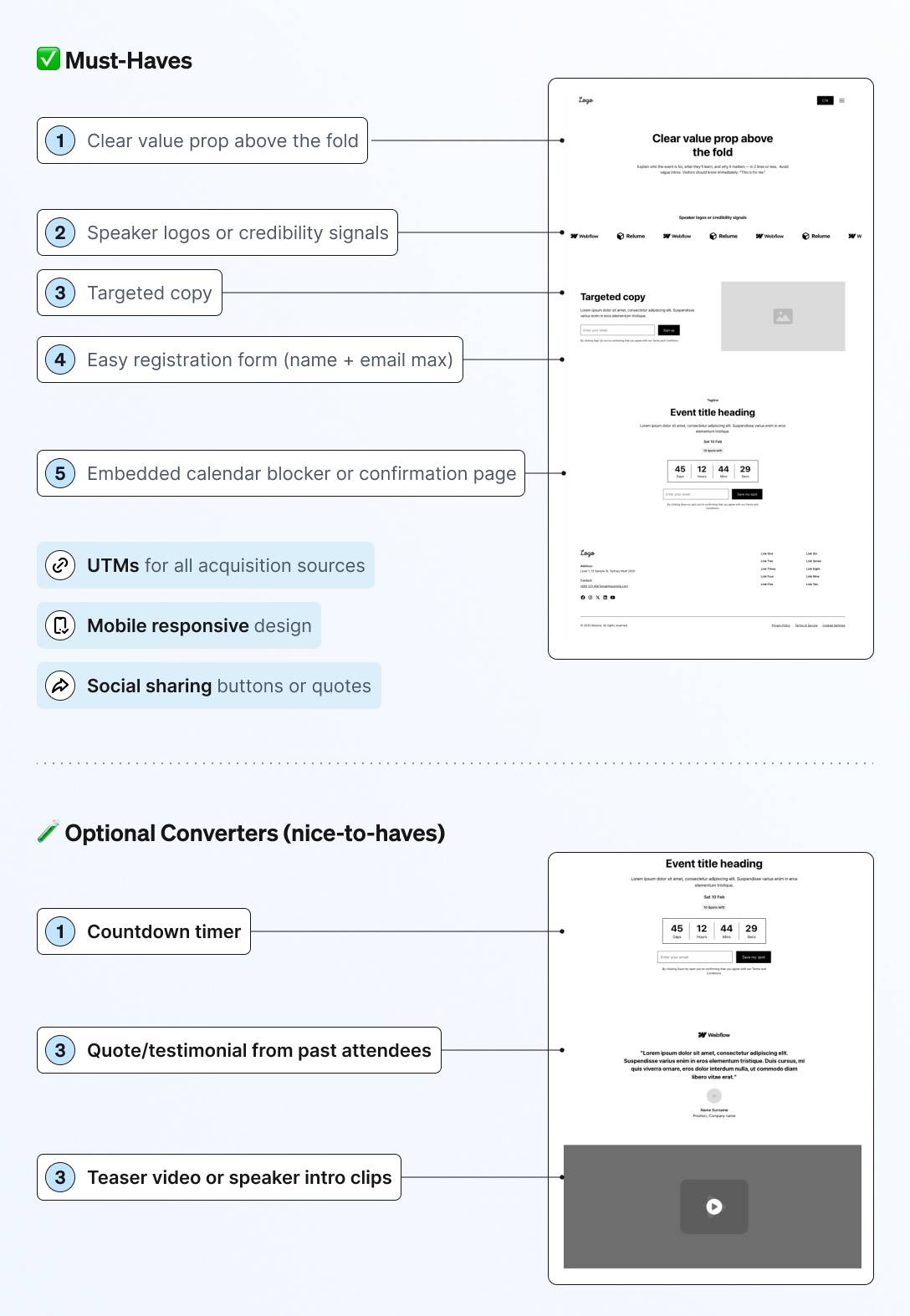
Expected results
Follow this playbook and you can expect to:
Cut manual research time by up to 70%, freeing your team to focus on strategy, not spreadsheets.
Double your event registrations with leads that are better qualified from the start.
Shift your time from hunting to optimising, refining campaigns for even stronger results.
Align sales and marketing around a crystal-clear target list, so everyone knows exactly who to reach and why.
Setzen Sie Erkenntnisse in Taten um
Erfolg im B2B bedeutet nicht, Leads hinterherzujagen!
Es geht darum, genau zu wissen, wen man wann ansprechen sollte.
